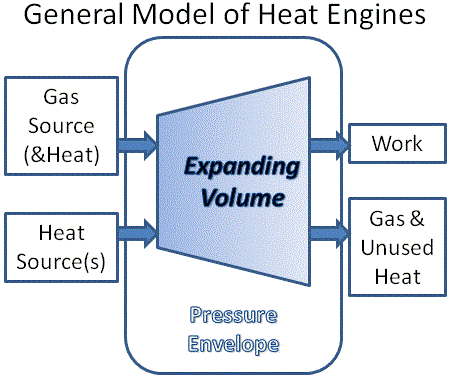
Someday, working with a real model of real heat engines, we will have engines pushing 100% efficiency. |
Since 1840, 170ish years ago, we know heat really is consumed in conversion to work. To the left is a heat engine model that includes all that is necessary and sufficient to build a heat engine. You can't have a heat engine without a gas (air, steam etc.), without volume constraint and change, or without a pressure envelope (on Earth at least).
Real engines produce motion with a pressure difference. The pressure envelope, usually our atmosphere, determines pressure requirements and limits. All the heat energy entering an engine emerges as heat or work.
The inside of a heat engine cannot tell what the external temperature is, so is unaffected by external temperatures, contrary to popular belief. Heat engines are not more efficient if greater temperature extremes are available. One cannot add liquid nitrogen to the output of a steam turbine or a car engine to get more work from the engine. Heat engines efficiency is determined solely by the amount of expansion, and what happens to unused heat, whether it is discarded or recycled, whether it leaks vapor or wastes work.
ALL HEAT ENGINES CONVERT HEAT TO WORK AT A RATE OF 100%. This is the First Law of Thermodynamics. It is Reversibility. It is Conservation of Momentum. They simply do not convert ALL the heat to work.
ALL heat engines are therefore equally efficient at converting heat to work. First shown in In "Reflections" by Sadi Carnot when he demonstrates "reversibility" . Heat can convert to work and back without loss.
Sadi Carnot and Lord Kelvin showed all Heat Engines behave the same, whether they use steam air or any other gas, the mechanics don't matter, the ONLY thing Heat Engines depend on is pressure and the amount of volume increase. They described how to make a perfect engine in 1820. Amounts to "don't discard heat". Not rocket science. |

